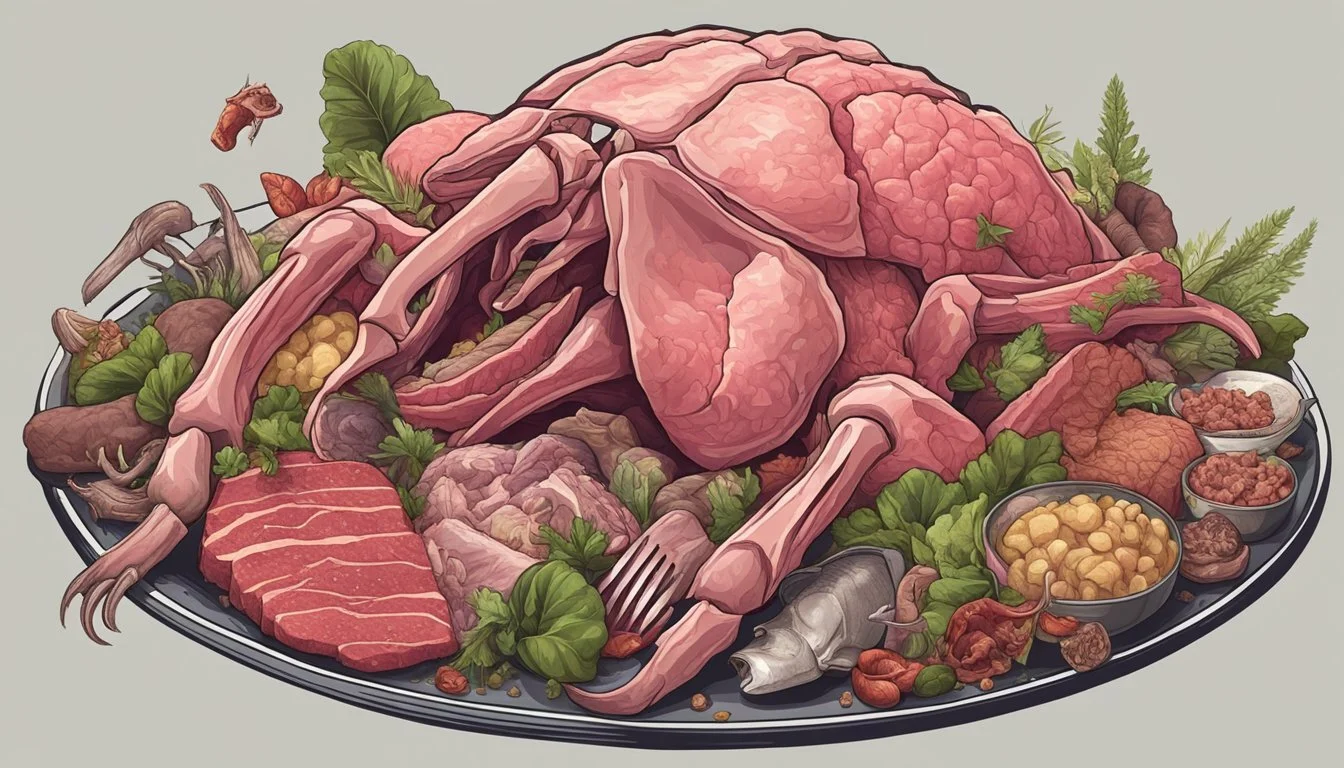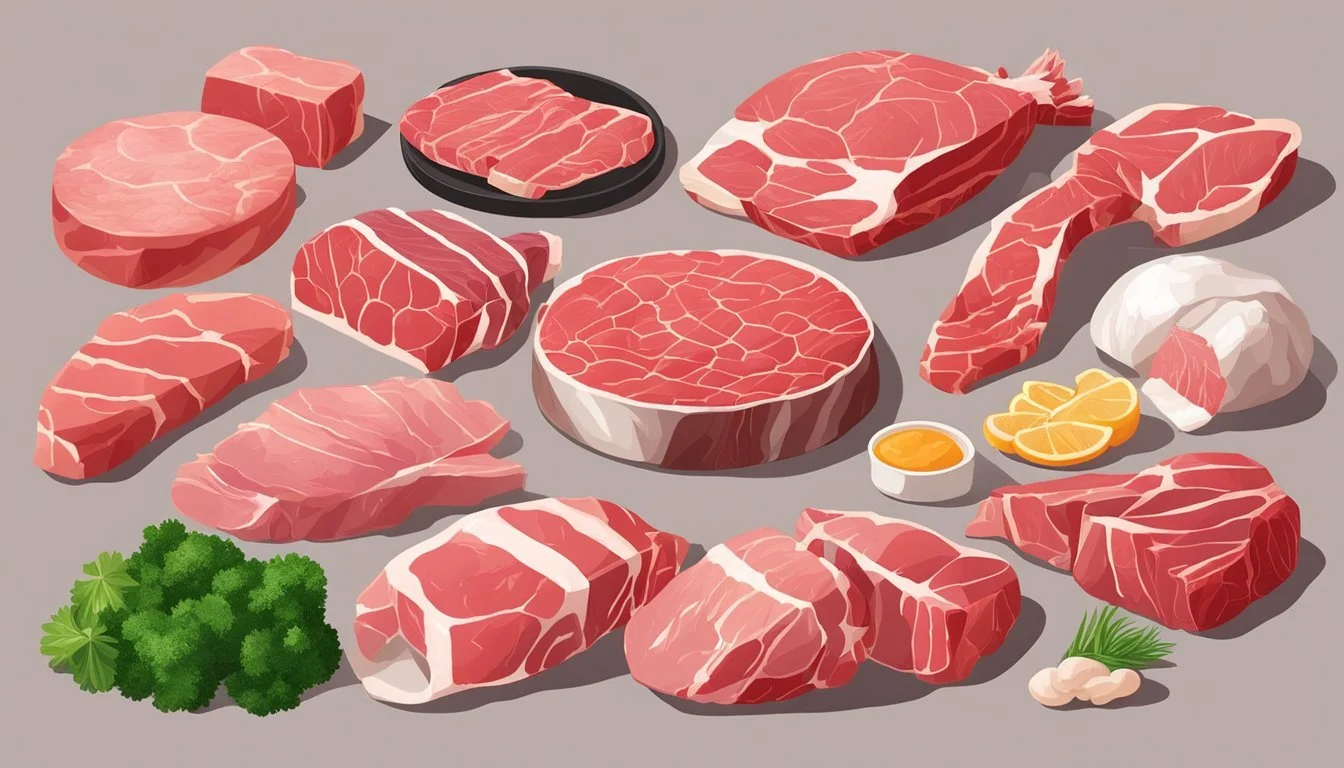Raw Meat Diet on Carnivore
Health Benefits and Risks
The raw meat diet on the carnivore diet offers an unconventional approach to health and nutrition by focusing exclusively on raw animal products. Proponents believe that eating raw meat can provide superior nutrient absorption and potentially better health outcomes. Followers of the raw meat diet within the carnivore framework often argue that it maximizes nutrient intake by preserving the enzymes, vitamins, and macronutrients that cooking may destroy.
Adherents typically include a range of raw animal products in their regimen, such as beef, bison, lamb, and fatty fish. They also emphasize freezing the meat for safety, which helps kill harmful pathogens. This lifestyle is not just about consuming muscle meat; organ meats and animal fats also play a crucial role, providing essential nutrients and energy.
The raw meat carnivore diet aims to simplify food choices while catering to those looking for potential health benefits. By eliminating plant-based foods, individuals may find relief from various digestive and inflammatory issues. With its unique approach, the raw meat diet intrigues those seeking a natural, straightforward path to wellness.
Understanding the Carnivore Diet
The carnivore diet focuses exclusively on consuming animal products, aiming to eliminate plant-based foods entirely. Various approaches exist within this diet, ranging from raw to cooked meat consumption.
Core Principles of the Carnivore Diet
The central tenet of the carnivore diet is the exclusive intake of animal products. This includes meat, eggs, and sometimes dairy.
The emphasis is placed on high-protein and high-fat foods. Dieters aim to achieve a state of ketosis, similar to the ketogenic diet. By excluding grains, vegetables, and fruits, followers believe they can reduce inflammation and promote better health.
The typical diet includes red meats such as beef and lamb, alongside fish, poultry, and organ meats. Water and occasionally bone broth are the main beverages. Followers prioritize the nutrient density of animal products over anything derived from plants.
Variations of Carnivore Diets
Common variations within the carnivore diet differ by the type and preparation of meat consumed. The raw meat version involves eating raw animal products, which some believe retains more nutrients.
For practical and safety reasons, some prefer cooked meat. Cooked meat tends to have a richer taste and is generally more acceptable for daily consumption.
Specialized methods include the "Lion Diet" which restricts intake to only red ruminant meats, salt, and water. Others might include dairy or fish depending on their specific dietary goals and tolerances.
Ancestral Eating and Modern Adaptations
The carnivore diet draws inspiration from ancestral eating habits, where early humans primarily consumed meat. Advocates argue that this diet aligns closely with human genetic adaptations for a meat-based diet.
Modern adaptations, like freezing meat to eliminate pathogens, help make the diet safer. It's also common to source grass-fed and pasture-raised meats which are considered healthier and closer to what our ancestors would have eaten.
This approach to eating is often paired with the notion that many modern diseases are a result of high carbohydrate and processed food intake, making the carnivore diet a return to simpler, more natural eating habits.
The Raw Meat Controversy
Exploring a raw meat diet within the carnivore framework involves assessing both its touted health benefits and the significant safety risks posed by pathogens and nutrient management.
Benefits of Consuming Raw Meat
Raw meat proponents emphasize the preservation of key nutrients. Vitamins like Vitamin C degrade at high temperatures, offering more nutritional value when consumed raw. B vitamins are also retained since they are water-soluble and compromised by cooking juices. The digestibility of raw meat may improve as cooking alters some protein structures, potentially making it easier for some individuals to process.
Additionally, some claim that the natural enzymes within raw meat aid in digestion and enhance mineral absorption. This focus on nutrient retention forms a core argument for those advocating raw consumption within a carnivore diet.
Potential Risks Associated with Raw Meat
Despite its nutritional benefits, consuming raw meat carries substantial risks. Bacteria like Salmonella and E. coli can be present, posing severe health hazards. Parasites are also a concern, with pathogens like Trichinella potentially leading to serious infections. The threat of foodborne illnesses necessitates stringent food safety measures.
Freezing meat for at least 14 days is one method to mitigate these risks by killing potential pathogens. However, this precaution isn't foolproof, and some pathogens may survive. The contamination risk from improper handling or sourcing of meat also cannot be ignored, making careful food preparation critical.
Balancing Nutrition and Food Safety
Finding a balance between nutrient intake and safety is essential. While raw meat may preserve more vitamins and minerals, ensuring pathogen-free meat through proper sourcing and handling is vital. Strategies include purchasing high-quality meat from reputable sources and implementing strict hygiene practices during preparation.
Cooking meat thoroughly can mitigate many safety concerns but may lead to nutrient loss. Individuals looking to reap the benefits of raw meat need to weigh these risks and consider partially cooking meat to achieve a balance. Emphasizing food safety while maximizing nutritional benefits enables a more sustainable approach to a carnivore diet.
Nutritional Considerations
A raw meat diet on the carnivore regimen provides a unique set of nutritional benefits and challenges. This section explores the macronutrients and micronutrients available in such a diet, the involvement of digestive enzymes and stomach acid, and the sources of essential vitamins and minerals.
Macro and Micronutrients in a Carnivore Diet
A carnivore diet primarily consists of protein and fats from animal products. Protein supports muscle maintenance and growth. Animal meats, particularly ruminants like beef and lamb, are rich in high-quality, complete proteins containing all essential amino acids.
Fats provide a dense source of energy. These fats include both saturated and unsaturated fats, vital for hormone production and brain health.
Micronutrients such as iron and zinc are abundant in red meats. Iron from red meat is heme iron, highly bioavailable and essential for oxygen transport and DNA synthesis. Zinc supports immune function and DNA synthesis.
The Role of Enzymes and Stomach Acid
Digestive enzymes play a crucial role in breaking down proteins and fats in a raw meat diet. Raw meat contains natural enzymes that can aid digestion. These enzymes start breaking down food in the mouth and continue their work in the stomach.
Stomach acid, or hydrochloric acid, creates an acidic environment that activates pepsinogen to pepsin, an enzyme that breaks down proteins into peptides. This acidic condition also helps in killing pathogens that might be present in raw meat, making the food safer to consume.
Vitamin and Mineral Sources
Raw carnivore diets provide essential vitamins and minerals, often lacking in processed foods. B vitamins, found in meat, are vital for energy production, nerve function, and red blood cell formation. Vitamin B12 is particularly important as it is only available in animal products.
While raw meat is low in vitamin C, the carnivore diet proponents argue that the absence of anti-nutrients like phytates (found in plant foods) may reduce the body's need for vitamin C, as it competes with glucose for uptake.
Minerals like zinc and iron are plentiful. Iron is crucial for preventing anemia, and zinc supports immune and reproductive health. Other minerals present include magnesium and selenium, which are important for metabolic processes and antioxidant protection.
The Impact of Cooking
Cooking meat transforms its taste, texture, and nutritional profile, impacting both nutrient retention and the formation of specific chemical compounds. It's a process that significantly alters the meat's composition, affecting nutrient availability and the formation of potentially harmful chemicals.
Cooking Techniques and Their Effects on Nutrients
Different cooking methods impact nutrient retention in meat. Grilling, roasting, and frying can cause significant nutrient loss. Vitamins B and C, which are water-soluble, often degrade under high temperatures. Minerals like potassium and phosphorus can leach out, particularly during boiling.
In contrast, steaming and sous-vide methods, which use lower temperatures, help retain more nutrients. For example, steaming preserves water-soluble vitamins better than boiling or frying. It's vital to consider cooking temperature and duration, as prolonged high-heat exposure increases nutrient degradation.
Chemical Changes: Maillard Reaction and AGEs
When meat is cooked, particularly at high temperatures, the Maillard reaction occurs. This reaction between amino acids and reducing sugars gives cooked meat its brown color and complex flavor.
However, the Maillard reaction also produces advanced glycation end-products (AGEs). High levels of AGEs, associated with grilling and frying, can contribute to adverse health effects.
Cooking meats, especially at temperatures above 285°F (140°C), can also produce polycyclic aromatic hydrocarbons (PAHs) and heterocyclic amines (HCAs), which are chemicals linked to an increased risk of certain cancers. Those concerned about these compounds should consider lower-heat cooking methods and avoid overcooking.
Potential Health Impacts
In a raw meat carnivore diet, the focus is on consuming raw animal products exclusively. The possible health impacts of such a diet can be significant, both positively and negatively, particularly affecting digestion, immune function, and risk of chronic diseases.
Digestive Health and Improved Digestion
Adopting a raw meat diet can affect digestive health. Some individuals report improved digestion, with fewer stomach issues and better nutrient absorption.
Raw meat provides bioavailable nutrients, meaning the body can absorb and utilize nutrients more efficiently. However, a lack of fiber—present in plant-based foods—could lead to constipation and other digestive issues.
It's crucial to be aware of the risk of foodborne pathogens which could cause severe gastrointestinal infections. Proper food handling and freezing meat for 14 days can reduce these risks.
I highly recommend purchasing fiber supplement online for a convenient shopping experience!
Immune Response and Inflammation
A raw meat diet may impact the immune system by influencing inflammation levels. Some proponents claim that such a diet can reduce chronic inflammation, potentially leading to lowered symptoms of autoimmune diseases.
Meat, especially when not processed, is rich in vitamins such as A, D, K2, and essential fatty acids, which support immune function.
Nevertheless, the diet's restrictiveness might lead to nutritional deficiencies affecting immune resilience over the long term. Eating high-quality meat products is crucial to mitigate some of these risks.
Chronic Diseases and Cancer Risk
The relationship between a raw meat diet and chronic diseases like heart disease and cancer is complex. While the diet is low in carbohydrates, which can stabilize blood sugar levels and potentially aid in weight loss, it lacks phytonutrients found in plants that are known to protect against chronic diseases.
Regular consumption of raw, high-quality meat might provide antioxidants that can reduce cancer risk, but this is still a debated area requiring more research.
Importantly, the absence of dietary fiber can negatively impact heart health, highlighting the need for balanced nutrient intake.
Lifestyle and Practical Considerations
Adapting to a raw meat diet on the carnivore regimen demands meticulous meal planning, awareness of economic costs, and consideration of convenient shopping methods. Each aspect plays a vital role in successfully maintaining this lifestyle.
Meal Planning and Preparation
Meal planning for a raw meat diet involves curating a variety of high-quality raw meats. Ruminant meats, such as beef, lamb, and bison, are staple choices.
A sample meal plan may include:
Breakfast: Raw beef liver
Lunch: Raw lamb chops
Dinner: Raw bison steak
Preparation is straightforward but requires strict adherence to hygiene practices. Sanitize all surfaces, and use dedicated utensils to avoid cross-contamination.
For safer consumption, freezing meat for 14 days is recommended to eliminate harmful pathogens.
Economic and Time Investments
The raw meat carnivore diet can be cost-intensive. Grass-fed and organic meats are preferred, and these can be pricier than conventional options.
An example budget breakdown:
Grass-fed beef (per week): $50-$100
Lamb and bison (per week): $60-$120
Time investment involves sourcing quality meats and preparing them. Since the diet avoids complex cooking, meal prep time is reduced but maintaining cleanliness and safe storage still requires effort.
Shopping and Meat Delivery Services
Shopping for a raw meat diet involves sourcing from reliable vendors. Farmer's markets and specialty butchers are good outlets for high-quality raw meats. Creating a detailed shopping list helps ensure nothing is overlooked.
Shopping list example:
6 lbs grass-fed beef
4 lbs lamb
4 lbs bison
Meat delivery services offer convenience by delivering fresh meat directly to your door. Services like ButcherBox and Crowd Cow provide a variety of meats that adhere to carnivore diet standards, saving time and effort in sourcing products.
Choosing reputable delivery services helps maintain the quality and safety of the meat, which is crucial for those following a raw meat regimen.
Incorporating Variety: Types of Meat and Cuts
In the raw meat carnivore diet, incorporating a range of meats and cuts enhances variety and ensures balanced nutrition. This guide covers red meats, poultry, seafood, specialty meats, and organ meats, offering insights into selecting the best cuts.
Red Meat, Poultry, and Seafood Options
Red Meat: Beef is a staple with cuts like porterhouse and filet mignon offering tenderness and flavor. Pork belly and pork chops provide rich options, while lamb adds a distinct taste.
Poultry: For those preferring lighter fare, chicken and turkey are lean but nutritious. Duck offers a fattier, flavorful alternative, suitable for maintaining calorie intake.
Seafood: Integrate fish, shrimp, and shellfish as excellent protein sources. Oily fish like salmon and mackerel supply essential omega-3 fatty acids.
Specialty Meats and Organ Meats
Specialty Meats: Incorporate less common meats like venison, bison, and rabbit. These meats not only diversify the diet but also pack a punch in terms of protein and nutrients.
Organ Meats: Liver, kidneys, and heart are nutrient-dense, offering vitamins and minerals not found in regular muscle meat. Bone marrow is another valuable addition, providing essential fats and nutrients to balance the diet.
Understanding Beef Cuts
Porterhouse Steak: Combines tenderloin and strip steak, prized for its tenderness and flavor. Ideal for those seeking a robust, satisfying meal.
Filet Mignon: Known for its tenderness, it comes from the smaller end of the tenderloin. Although leaner, it still provides a melt-in-the-mouth texture.
Ribeye: Cut from the rib section, it's known for marbling and rich flavor. Perfect for grilling or pan-searing due to its fat content.
T-Bone Steak: Features a T-shaped bone with meat on both sides. It includes parts of the tenderloin and strip steak, combining different textures and flavors.
Flank Steak: Comes from the abdominal muscles, it's lean yet flavorful. Best when marinated and cooked to medium-rare to avoid toughness.
Short Ribs: Cut from the rib and plate primals, they are meaty and rich in flavor, suitable for slow cooking to break down the connective tissues.
Common Concerns and Misconceptions
When it comes to the raw meat diet on the carnivore plan, several concerns often arise regarding nutrients, fats, and safety. Addressing these can help clarify doubts and ensure a well-informed dietary choice.
Addressing Nutrient Imbalances
One common concern is the potential for nutrient imbalances. Critics argue that a diet devoid of plant foods may lack essential vitamins and minerals. In reality, most nutrients can be adequately sourced from animal products. For instance, Vitamin B12, iron, and zinc are abundant in red meats like beef and lamb.
Organ meats, such as liver, are rich in vitamins A and D, which help balance the nutrients. Omega-3 fatty acids found in fatty fish like salmon also contribute to overall health. To ensure dietary adequacy, it's crucial to incorporate a variety of animal products and consider supplements if necessary.
Debunking Myths About Saturated Fat
Skepticism about the raw meat carnivore diet often includes fears around saturated fat. Many studies reveal that saturated fat is not a primary cause of heart disease as previously thought. Instead, it plays a significant role in hormone production and cell membrane integrity.
Choosing high-quality sources of saturated fat, such as grass-fed beef or pastured meats, provides beneficial fatty acids without harmful additives. The misconception linking saturated fat to health risks stems from outdated research; more recent findings support its inclusion within a balanced carnivore diet.
Hygiene and Contamination Myths
Concerns about hygiene and contamination are prominent when it comes to consuming raw meat. Proper handling and preparation are essential to mitigate risks. Freezing meat for at least 14 days can reduce harmful pathogens, making it safer for consumption.
Proper storage, clean preparation surfaces, and avoiding cross-contamination are crucial practices. While some worry about carcinogens, the absence of cooking reduces exposure to potentially cancer-causing compounds like heterocyclic amines, which form when meat is cooked at high temperatures.
Overall, maintaining a strict hygiene regimen and being mindful of meat sources can address most concerns about contamination and hygiene. Following these guidelines can make the raw meat diet both safe and nutritionally sufficient.






